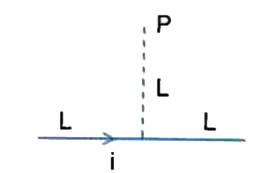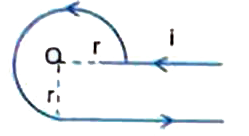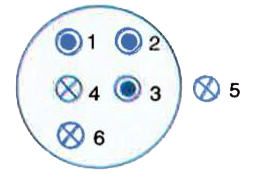Complete Solutions to PROBLEMS (LEVEL -I) of chapter ELECTROMAGNETICS of Class 12 book with complete answers and questions
| Class 12 | PHYSICS |
| Chapter | ELECTROMAGNETICS |
| AAKASH SERIES | PROBLEMS (LEVEL -I) |
| Number Of Questions | 30 |
| Academic Year | 2023-24 |
A long straight wire carries a current of 50 A. What is the magnitude of intensity of magnetic induction at a point 15 cm from the wire.
View SolutionA wire carrying a current of 125 A is bent into the form of a circle of radius 5 cm. Calculate the flux density at the centre of the coil.
View SolutionA current of 4A is flowing through a circular coil of radius 20 cm containing 200 turns. Find the magnetic flux density at the centre of the coil.
View SolutionA long straight conductor carrying a current of 4 A is in parallel to another conductor of length 5 cm and carrying a current 9 A. They are separated by a distance of 10 cm. Calculate (a) B due to first conductor at second conductor (b) The force on the short conductor.
View SolutionTwo parallel conductors A and B separated by 15 cm carry electric current of 9 A and 4 A in the same direction. Find the point between A and B where the field is zero.
View SolutionThe area of the coil in a moving coil galvanometer is `8 cm^2` and has 10 turns. The magnetic induction is 0.1 T and the couple per unit twist of the suspended fibre is `10^(-6)` Nm per degree. If the deflection is `90^0`, calculate the current passing through it
View SolutionA coil of area `150 cm^2` having 250 turns carriers a current of 2 mA. It is suspended in a uniform magnetic field of induction `9 xx 10^(-3) "Wbm"^(-2)`. Its plane makes an angle of `60^0` with the line of induction. Find the torque acting on the coil.
View SolutionA galvanometer of resistance `30 Omega` is shunted by a `30 Omega` resistor. What part of the main current flows through the meter ?
View SolutionA maximum current of 1.5 mA can be passed through a galvanometer of resistance `30 Omega`. Calculate the resistance to be connected in series to convert it into a voltmeter of range 0-9V.
View SolutionA galvanometer has a resistance of 500 ohm. It is shunted so that its sensitivity decreases by 100 times. Find the shunt resistance.
View SolutionA galvanometer has a resistance of `100 Omega`. A current of `2 xx 10^(-3)` A can pass through the galvanometer. How can it be converted into (a) Ammeter of range 20 A and (b) oltmeter of range 20 V?
View SolutionThe resistance of a galvanometer is 999 `Omega`. A shunt of `1 Omega` is connected to it. If the main current is `10^(-2)` A, what is the current flowing through the galvanometer?
View SolutionA galvanometer has a resistance of `96 Omega`. If 4% of the main current is to be passed through the meter, what should be the value of the shunt?
View SolutionA circular coil of wire of radius 'r' has 'n' turns and carries a current T. Find the magnetic induction (B) at a point on the axis of the coil at a distance `sqrt(3)r` from its centre ?
View SolutionA circular coil of radius 3cm has 50 turns. It is placed on the horizontal plane and a current of 3A flows through it in clockwise direction as seen from above. Calculate the magnetic field at a point on the axis of the coil, at a distance of 4cm from its centre. Also indicate the direction of the magnetic field.
View SolutionA cable 5 m above the ground carries a current of 50 A from south to north. Find the direction and magnitude of the magnetic field on the ground directly below the cable.
View SolutionThe electron in the hydrogen atom circles around the nucleus with a speed of `2.0 xx 10^6 ms^(-1)`in an orbit of `5.3 xx 10^(-11)` m. What is the magnetic field at the centre of the nucleus?
View SolutionA solenoid of infinite length consists of a single layer 1000 turns per unit length of a wire carrying a current of 2mA. Calculate the magnetic field on the axis at the middle of the solenoid.
View SolutionA long straight wire carries a current of 4A. A proton travels with a velocity of `4 xx 10^4 ms-1` parallel to the wire 0.2m from it and in a direction opposite to the current. What is the force which the magnetic field due to current exerts on the moving proton?
View Solution10 A and 2A currents are passed through two parallel wires A and B respectively in the opposite directions. If the wire A is infinitely long and the length of wire B is 4 m, which is 10cm away from the wire A, calculate the force on the wire 'B'
View SolutionTwo infinitely long parallel wires 5 cm apart in air carry currents of 2A and 4A respectively. Find the magnitude of the force on each metre of wire if currents are (i) in the same direction. (ii) in opposite direction.
View SolutionA horizontal wire of length 0.2m long carries a current of 3A. Find the magnitude of the magnetic field, which can support the weight of the wire. Mass per unit length of wire is `2 xx 10^(-3) kg m^(-1)`
View SolutionA rectangular coil of sides 12cm and 8cm having 1000 turns and carrying current of 100mA is held in a uniform magnetic field of 0.1 Tesla. What is the maximum torque the coil can experience ?
View SolutionA coil of 20 turns of area `8 xx 10^(-2) cm^2` with its plane parallel to the magnetic field of intensity 3000G and carrying a certain current experiences a torque `2.4 xx 10^(-3)` Nm .Calculate the value of current.
View SolutionFigure shows a straight wire of length L carrying a current i. Find the magnitude of magnetic field produced by the current at point P.

View SolutionA particle of mass m and charge q moves with a constant velocity V along the positive x-direction . It enters a regio containing a uniform magnetic field B directed along the negative z-direction, extending from x = a to x = b . The minimum value of V required, so that the particle can just enter the region of `x gt b ` is
View SolutionFind the magnetic induction at point O, if the current carrying wire is in the shape shown in the figure.

View SolutionSix wires of current `I_1 = 1A, I_2 = 2 A, I_3 = 3A, I_4 = 1A, I_5 = 5A` and `I_6 = 4A` cut the page perpendicularly at the points 1, 2,3,4,5 and 6. respectively as shown in the figure . Find the value of the integral ` oint vec B.d vec1` around the closed path.

View SolutionElectric charge q is uniformly distributed over a rod of length 1. The rod is placed parallel to a long wire carrying a current i. The separation between the rod and the wire is a. Find the force needed to move the rod along its length with a uniform velocity v.
View SolutionA charged particle (charge q, mass m) has velocity vo at origin in +x direction. In space there is a uniform magnetic field B in-z direction. Find the y coordinate of particle when it crosses y axis.
View Solution
PROBLEMS (LEVEL -I) questions and complete solutions for chapter ELECTROMAGNETICS of JEE (MAIN AND ADVANCED) PHYSICS of Class 12